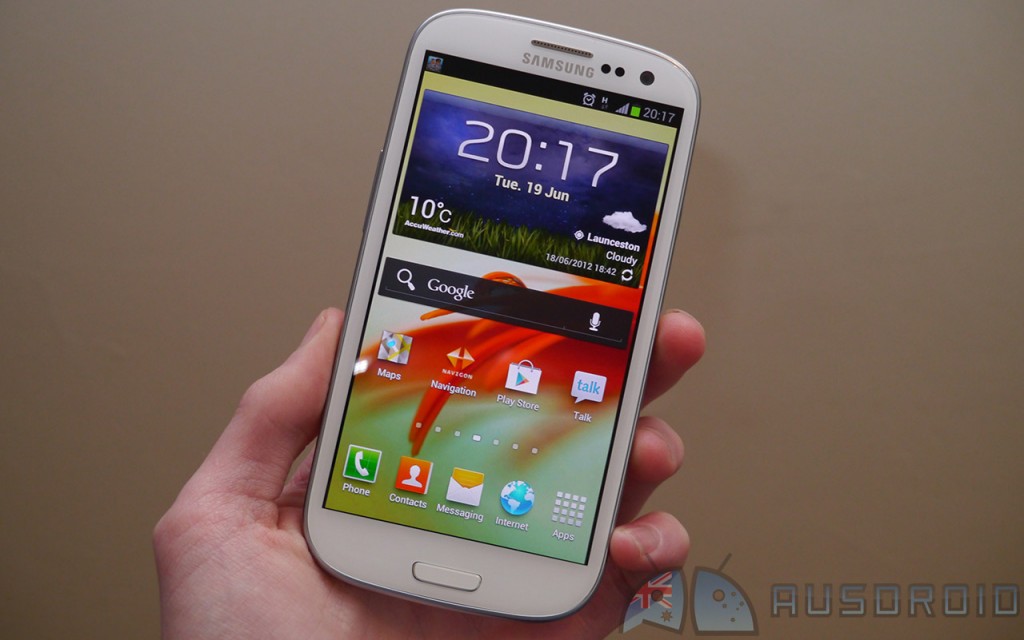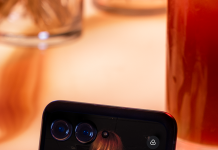
Samsung’s latest flagship is good, but is it good enough to fend off the competition?
You may have watched the launch of the Galaxy S III live from London, almost six weeks ago. At some point you may have been horrified with the nature theme (pebbles, water, etc) and the “made for humans” catch cry. Honestly, I still cringe a bit when I see a commercial with those words in it.
Perhaps you were disappointed with the plasticky (actually polycarbonate) materials used in its construction or the Pentile pixel arrangement used in its display. These issues were well discussed in the tech world immediately following the launch.
If your response to these issues was a concerned or negative one, you certainly weren’t alone. It was with these same thoughts “buzzing around” in the back of my own mind that I nervously attended the Australian launch of the Galaxy S III a couple of weeks ago. Since then I have been carefully considering the pros & cons of the most eagerly awaited Android phone of 2012.
Throughout my time with the Galaxy S III I have compared it with my own daily driver – the Galaxy Nexus; which is (in my opinion) the standard-bearer for Android 4.0 phones in terms of the software experience.
In my own mind, the primary question from the very outset has been this: Is the Galaxy S III a phone that I would want to make my own? Is it worthy of my choosing? Is it worthy of yours? Basically, could I recommend it? Let’s see.
- Smooth navigation throughout the OS
- Efficient use of power
- Excellent camera (for a phone)
- Ergonomic design
- Huge, bright, clear display
- Home button is awkward to press
- TouchWiz deviates too far from ICS “Holo Theme”
- No 4G or DC-HSPA+
- Bland design
- Auto-brightness is too jumpy, and low.
Performance..
The word that comes to mind is ‘Effortless’. Navigating home screens, the app drawer and the bundled applications gives you the feeling that the phone is taking everything in its stride. It’s a bit like skimming a smooth stone across a calm lake. You know effort is needed to hurl that stone but what is seen is the graceful skimming across the water. See what I did there?
Honestly, I have no idea how many of those four cores are at work during different operations but the phone rarely skips a beat. With some phones (even my Galaxy Nexus) some applications will lack the smooth, effortless behaviour I’m referring to. The Galaxy S III has powered through everything I’ve thrown at it without breaking a sweat. The only time it faltered was when I had three different cameras running at the same time – understandable, I’d say.
Battery..
Perhaps even more than its effortless power, I loved its ‘Efficiency’. For the first couple of days my usage was heavy. I could not kill the battery in a full day’s use! Other days were moderate. Weekends are usually light use; depending what’s happening in my world. I will say this: With light to moderate use you can get through the weekend without looking for a power point.
Depending how many accounts you have syncing in the background and how often you have them notifying you, I have no doubt you could get through 3-4 days of light use – particularly on wifi. I did manage 2.5 days last weekend with mixed use. Unfortunately, as it is with these things, your mileage may vary. I’m sure you could kill the battery in half a day if you sat there playing games or streaming video non-stop on full brightness.
Oh, Smart Stay actually worked (kept the screen on while I was looking at it) except in a dark place where it couldn’t see my face. I set the Screen Timeout to 15 seconds so it would turn off quickly if I wasn’t using it. In daylight I forgot I even had a timeout. I would estimate a 90% success rate unless it was dark. Again, your mileage may vary.
Camera..
I’ve used the Galaxy Nexus as my main camera for the last 6 months. In the 6 months prior, it was the Galaxy S II. On a personal level, this is the make or break feature for me. If you’ve used a Galaxy S II you will know that the interface has much of the granularity of a Samsung Digital Camera. There are a few more options but it’s basically the same layout. It’s feature laden but not simple. Those of you upgrading from a Galaxy S II (or most pre 2012 phones) will be happy to know that the Galaxy S III has a super fast shutter to go along with its new sensor.
That sensor! Sony deserves the credit here. They have created a fantastic little bit of optical genius that lets in lots of light, even in low light areas – compared to other phones, that is. Don’t expect to replace your DSLR with this though. Teardowns show that it is pretty much the same sensor that’s used in the iPhone 4S. Make of that what you will! Suffice to say, I managed to get some results that I was happy with, both in bright and low light scenes. Free tip: use Night Mode at night and make sure you hold as still as possible.
In terms of video performance, it’s pretty darn good. Couple that sensor with Samsung’s encoding experience (they’ve been doing this a long time) and you have little reason to spend money on a dedicated digital camcorder of the cheaper variety – except maybe for better stabilisation. Note: If you upload to YouTube they do a great job of fixing shakiness for you!
Specifically we’re talking High Profile @ Level 4.0 AVC encoding at 16.7 Mbps & a 29.4 fps ave frame rate for 1080p video capture. They’re the deets that Media Info is reporting to me on the sample I just shot. The YouTube sample will be compressed but still looks good. Also, the 1.9 MP front facing camera shoots the best HD video chat or vanity pics you can get on a phone at the time of this review, period.
Display..
That display! It is lovely. And big! HTC OneX / XL owners will chip in here and tell you that their display is better [It’s made by Samsung, incidentally ;-)] and in terms of brightness and natural colour tones, they’d be right. But seriously, the display on the Galaxy S III has a beauty of it’s own. Pentile haters can get their microscopes out and go for their lives if they like. It’s all pointless though because none of their complaints are discernible in normal daily use.
Listen people: There are no funky greys or whites (known as luminance grain) that plague the Galaxy Nexus to be seen on the Galaxy S III. The blue tinge that is seen from extreme angles (do you use your phone like that?) on Amoled displays I have not noticed at all on the Galaxy S III. What I have noticed is stunning blacks (better than on any LCD display) and superb contrast (the measurable/visible difference between the darkest and lightest points the display is capable of) that makes colours really ‘pop’. If that’s not your thing you can adjust it with one of the 4 screen modes in the display settings. Please forgive that rant!
Audio..
Briefly, audio performance and quality with music is best in class thanks to a dedicated Wolfson DAC on board. Yes, this means Voodoo sound is possible people! Also, call performance is excellent thanks to a secondary noise cancellation microphone that worked well for me. I used a Telstra sim.
Design..
Lastly, and most contentiously; The Design. It appears in both the Pro and Con list. It is a Pro because it feels absolutely natural in the hand. Also, Samsung have worked some incredible magic in making the coating, which they call hyperglaze, to be so smooth yet quite grippy. It looks like it will slip out of your hand, but it doesn’t. Go figure? Also, despite not looking incredibly robust, it seems not to get scratched. Remember the back of the original Galaxy S or Nexus S? Shiny, scratchy yuck 🙁 If you’re concerned about it picking up stains (I have the white version) fear not, it doesn’t.
For what it’s worth, there is none of the creaking, flexing or poorly fitting componentry associated with neglectful design or construction. In the hand it feels solidly made and amazingly comfortable despite it’s size. I like that it’s not hefty, like a big aluminium phone, but I’m not so naive as to think that all of you guys will share this sentiment.
Some of these issues here present are long-term areas of need for Samsung to work on. Some of them may be deal-breakers for you. Some of them are minor. Here we go…
Auto Brightness..
Auto Brightness tends to jump around a bit. It doesn’t adjust gradually, which would be ideal, but rather it jumps quickly from dark to light and vice versa. I noticed it more in the first couple of days of use – honestly, I’m not sure if the phone adapted to it’s differing environments or maybe I just got used to it. Thing is, other phones do it better.
Still on Brightness, it seems Samsung has opted for a slightly lower default auto setting than most other phones I’ve used – probably to save battery. My Galaxy Nexus is quite similar. Maybe it’s an Amoled thing? I certainly don’t notice it on my Nexus S. Galaxy S II is Amoled though and plenty bright. Anyway, it’s too low at times.
Custom Overlay..
Here’s another subject to set the Cat amongst the Pigeons: Touchwiz4. Samsung’s insistence on a Colourful, Cartoony, Gingerbready user overlay. To be frank, I actually didn’t mind it too much. It’s a matter of opinion I guess. I realise some people hate it! Personally, I prefer the Holo Theme of stock Ice Cream Sandwich that appears on the Galaxy Nexus. Samsung don’t want to put off previous Galaxy S owners – I get that. Still, it’s getting a bit old now and it messes with Android 4.0’s core design language. That’s all I’ll say. If you want more detail, we regularly discuss these things on the Ausdroid Podcast and usually rant about them!
Home & Capacitive Buttons..
The Home Button. It’s harder to press than the ones on the previous Galaxy S phones. It’s kinda narrow and takes some getting used to. I don’t like it. I hope they change it in the next model. People with big fingers may find it quite difficult. Let me know in the comments. Is it just me?
Although I love having more display at my disposal thanks to the capacitive buttons being below the screen, in practice the operation is a lot slicker and more accurate with on screen buttons. My Galaxy Nexus is just plain easier to use with on screen buttons. I will say, however, that the “return” of the menu button being down the bottom is quite welcome. The 3 dot action button is something Google hasn’t perfected yet, in my opinion.
No 4G..
If 4G (and Dual Carrier HSPA+ when outside 4G areas) is really what you’re after and you’re in an area that supports it, you don’t want the International version of the Galaxy S III. Sorry to be blunt, but it’s just not there. Admittedly, this is only a concern if you’re going with Telstra right now,here in Australia. Telstra may release a 4G version soon. We’ll have to wait and see. Personally, I had no issues using HSPA+ on the Galaxy S III.
I found it was fast enough to do 99% of my tasks without any drawbacks. The 1% would probably be if I wanted to upload or stream a very large file – like a 1080p video perhaps. If you’re a 4G evangelist, feel free to list the advantages in the comments section. In the areas I moved around Melbourne I regularly saw speeds between 4-12 Mbps in the downlink and 0.3 to 3.6 Mbps in the uplink. If you need more than this I would suggest the HTC One XL. You can read our review here.
Design & Construction..
Lastly: The Design. The front looks OK. The back is uninspiring at best. From the side it looks quite good: Surprise, surprise! Although, up close its fake metal rim is just that – faux metal. ie Plastic. The Galaxy Nexus is more visually appealing and that’s not saying much. The white One X has a leg up in this area with a stunning design which is beautifully crafted. By comparison, The Galaxy S III is Plain Jane. It’s not ugly, but not gorgeous either. Beauty is in the eye of the beholder so you be the judge for yourself. Note: It is amazing how much vanity plays a part in smartphone ownership!
Is the design a deal breaker? You must answer that for yourself. For me it’s not. Does that mean I wouldn’t like it to be more visually appealing? No way!
[nggallery id=131]
Specs..
- Exynos 4 Quad (4412) Quad Core Cortex A9 CPU
- ARM Mali400MP4 GPU
- Android 4.0.4 w/ TouchWiz 4 UI
- 4.8-inch 1280×720 (306 PPI) SAMOLED HD Display
- 850/900/1900/2100MHz HSPA+ (21.1Mbps / 5.76Mbps)
- 16/32GB Internal Storage + microSD card slot for up to 64GB External Storage, 1GB LPDDR2 RAM
- Wi-Fi a/b/g/n, Bluetooth 4.0
- 8MP Rear Camera with 1080p/30 & 1.9MP Front Camera with 720p/30
- 2100mAh Battery
- Wolfson DAC
The Galaxy S III is easy to recommend to anyone looking for a Top-of-the-line Android phone. Opinion is divided on whether it’s better than it’s biggest Android competitor – the HTC One X / XL. Check out our reviews of those phones too!
If a fast, fluid experience is what you’re after, there’s really no better Android phone at this time than the Galaxy S III. Samsung has matched powerful hardware with optimised software to create an enjoyable experience that will last all day thanks to great battery life.
If you’re a design snob (It’s ok, I’m a coffee snob) you may prefer the One X. If you’re a 4G snob you’ll likely prefer the One XL. If those things aren’t crucial for you then I would suggest the Galaxy S III is as good as it gets right now in terms of overall features (many I cannot list due to space) and performance.










